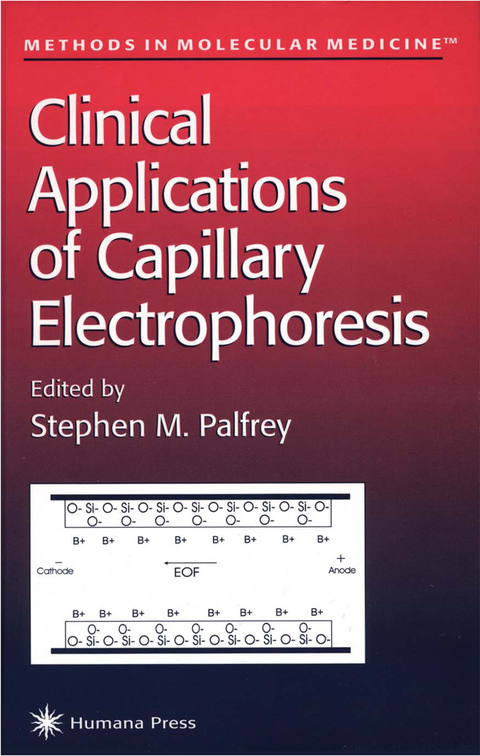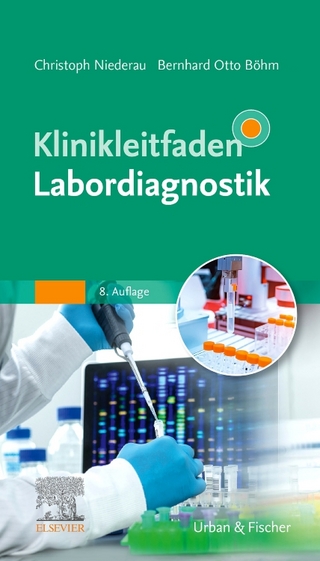
Clinical Applications of Capillary Electrophoresis
Humana Press Inc. (Verlag)
978-0-89603-639-0 (ISBN)
The term "electrophoresis" was first used by Michaelis in 1909, to - scribe the migration of colloids in an electric field. The first practical elect- phoresis method was described by Tiselius in 1937. He used a U-tube filled with buffer layered on top of sample; migration could be monitored using Schlieren optics. In zone electrophoresis, the U-tube was replaced by paper, a support material employed simply to prevent or minimize diffusion of ions, so that ions applied in a narrow strip to the paper will separate and remain as relatively discrete zones. Paper was superceded by a variety of other media, - cluding cellulose acetate, hydrolyzed starch (starch gel), agarose, and polyacry- mide. The latter, in addition to being a support medium, has size-sieving properties. From the basic zone electrophoresis, other means of separation have been dev- oped. These include, isoelectric focusing, isotachophoresis, density gradient el- trophoresis, and various forms of immunoelectrophoresis. In some ways Capillary Electrophoresis (CE) has gone full circle back to the original method of Tiselius.
In its simplest form, separations occur in a buffer solution within a glass (fused silica) tube and detection occurs as sample moves past an optical window. CE has rapidly developed into a technique that rivals HPLC in its versatility. All the classical electrophoretic separations-zone, IEF, and isotachophoresis-have their counterparts in CE. Excitingly so, and - thoritatively treated in Clinical Applications of Capillary Electrophoresis.
Clinical Applications of Capillary Electrophoresis.- Serum Protein Electrophoresis.- Urine Proteins.- Electrophoresis of Cerebrospinal Fluid.- Immunosubtraction as a Means of Typing Monoclonal and Other Proteins in Serum and Urine.- Analysis and Classification of Serum Cryoglobulins.- Myoglobin Analysis.- Enzyme Analysis.- Quantification of Human Cytomegalovirus by Competitive PCR and Capillary Electrophoresis.- Laboratory Diagnosis of Structural Hemoglobinopathies and Thalassemias by Capillary Isoelectric Focusing.- Serum Apolipoproteins.- Gene Dosage in Capillary Electrophoresis.- Rapid Analysis of Amplified Double-Stranded DNA by Capillary Electrophoresis with Laser-Induced Fluorescence Detection.- Identification of Mutated p53 in Cancers by Nongel-Sieving Capillary Electrophoretic SSCP Analysis.- Detection of Microsatellite Instability in Cancers by Means of Nongel-Sieving Capillary Electrophoresis.- Serum Lamotrigine Analysis.- Acetonitrile Stacking.- Confirmation of the Presence of Drugs of Abuse in Urine.- Steroid Analysis by Micellar Electrokinetic Capillary Chromatography.- Determination of Polyamines by Capillary Electrophoresis.- Urinary Oxalate and Citrate.- Plasma Nitrite and Nitrate Determination.
| Erscheint lt. Verlag | 1.6.1999 |
|---|---|
| Reihe/Serie | Methods in Molecular Medicine ; 27 |
| Zusatzinfo | 32 Illustrations, black and white; XII, 212 p. 32 illus. |
| Verlagsort | Totowa, NJ |
| Sprache | englisch |
| Maße | 155 x 235 mm |
| Themenwelt | Medizin / Pharmazie ► Medizinische Fachgebiete |
| Studium ► 2. Studienabschnitt (Klinik) ► Anamnese / Körperliche Untersuchung | |
| Studium ► 2. Studienabschnitt (Klinik) ► Pathologie | |
| Technik ► Medizintechnik | |
| ISBN-10 | 0-89603-639-1 / 0896036391 |
| ISBN-13 | 978-0-89603-639-0 / 9780896036390 |
| Zustand | Neuware |
| Haben Sie eine Frage zum Produkt? |
aus dem Bereich


